Research Proposal: Waste Management Analysis for British Petroleum
VerifiedAdded on 2021/04/21
|19
|4146
|50
Report
AI Summary
This research proposal critically analyzes the importance of waste management, using British Petroleum (BP) as a case study. It explores the background of the oil and gas industry, highlighting the challenges BP faces in sustainable waste management. The study aims to identify key challenges, compare factors affecting waste management in developed and emerging oil areas, and recommend new waste management systems. The literature review covers waste management concepts, resources, and regulations, including hydraulic fracturing waste and disposal options. The research methodology outlines data collection, analysis, limitations, and expected outcomes, including a Gantt chart. The proposal seeks to answer critical research questions regarding the challenges, comparative factors, and innovative waste management approaches within the oil industry. The proposal also covers the importance of waste management, and the different methods of waste management like landfill, recycling and waste hierarchy.

Running head: RESEARCH PROPOSAL
A Critical analysis of the importance of waste management: case study BP
Name of the Student
Name of the University
Author Note
A Critical analysis of the importance of waste management: case study BP
Name of the Student
Name of the University
Author Note
Paraphrase This Document
Need a fresh take? Get an instant paraphrase of this document with our AI Paraphraser
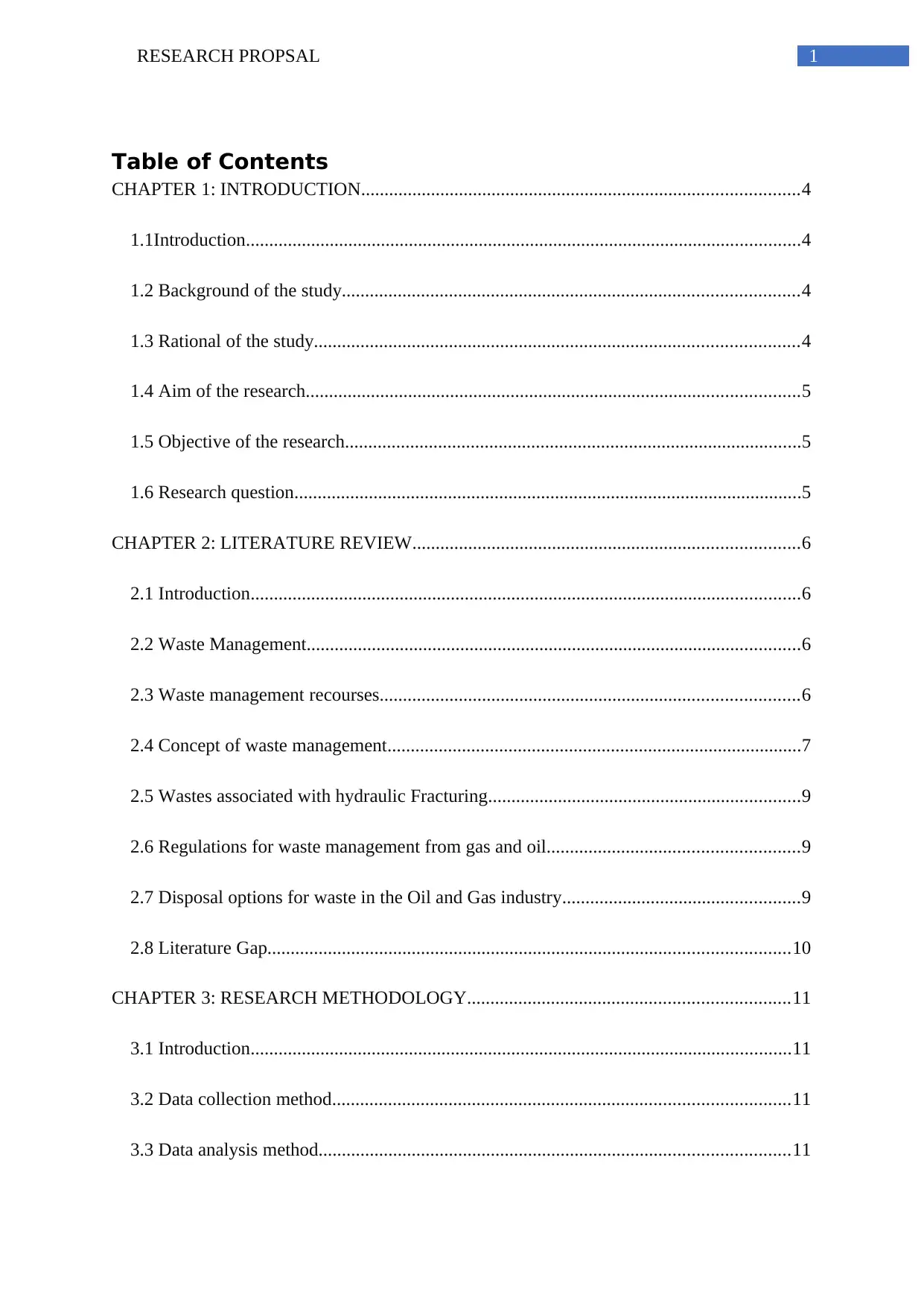
1RESEARCH PROPSAL
Table of Contents
CHAPTER 1: INTRODUCTION..............................................................................................4
1.1Introduction.......................................................................................................................4
1.2 Background of the study..................................................................................................4
1.3 Rational of the study........................................................................................................4
1.4 Aim of the research..........................................................................................................5
1.5 Objective of the research..................................................................................................5
1.6 Research question.............................................................................................................5
CHAPTER 2: LITERATURE REVIEW...................................................................................6
2.1 Introduction......................................................................................................................6
2.2 Waste Management..........................................................................................................6
2.3 Waste management recourses..........................................................................................6
2.4 Concept of waste management.........................................................................................7
2.5 Wastes associated with hydraulic Fracturing...................................................................9
2.6 Regulations for waste management from gas and oil......................................................9
2.7 Disposal options for waste in the Oil and Gas industry...................................................9
2.8 Literature Gap................................................................................................................10
CHAPTER 3: RESEARCH METHODOLOGY.....................................................................11
3.1 Introduction....................................................................................................................11
3.2 Data collection method..................................................................................................11
3.3 Data analysis method.....................................................................................................11
Table of Contents
CHAPTER 1: INTRODUCTION..............................................................................................4
1.1Introduction.......................................................................................................................4
1.2 Background of the study..................................................................................................4
1.3 Rational of the study........................................................................................................4
1.4 Aim of the research..........................................................................................................5
1.5 Objective of the research..................................................................................................5
1.6 Research question.............................................................................................................5
CHAPTER 2: LITERATURE REVIEW...................................................................................6
2.1 Introduction......................................................................................................................6
2.2 Waste Management..........................................................................................................6
2.3 Waste management recourses..........................................................................................6
2.4 Concept of waste management.........................................................................................7
2.5 Wastes associated with hydraulic Fracturing...................................................................9
2.6 Regulations for waste management from gas and oil......................................................9
2.7 Disposal options for waste in the Oil and Gas industry...................................................9
2.8 Literature Gap................................................................................................................10
CHAPTER 3: RESEARCH METHODOLOGY.....................................................................11
3.1 Introduction....................................................................................................................11
3.2 Data collection method..................................................................................................11
3.3 Data analysis method.....................................................................................................11
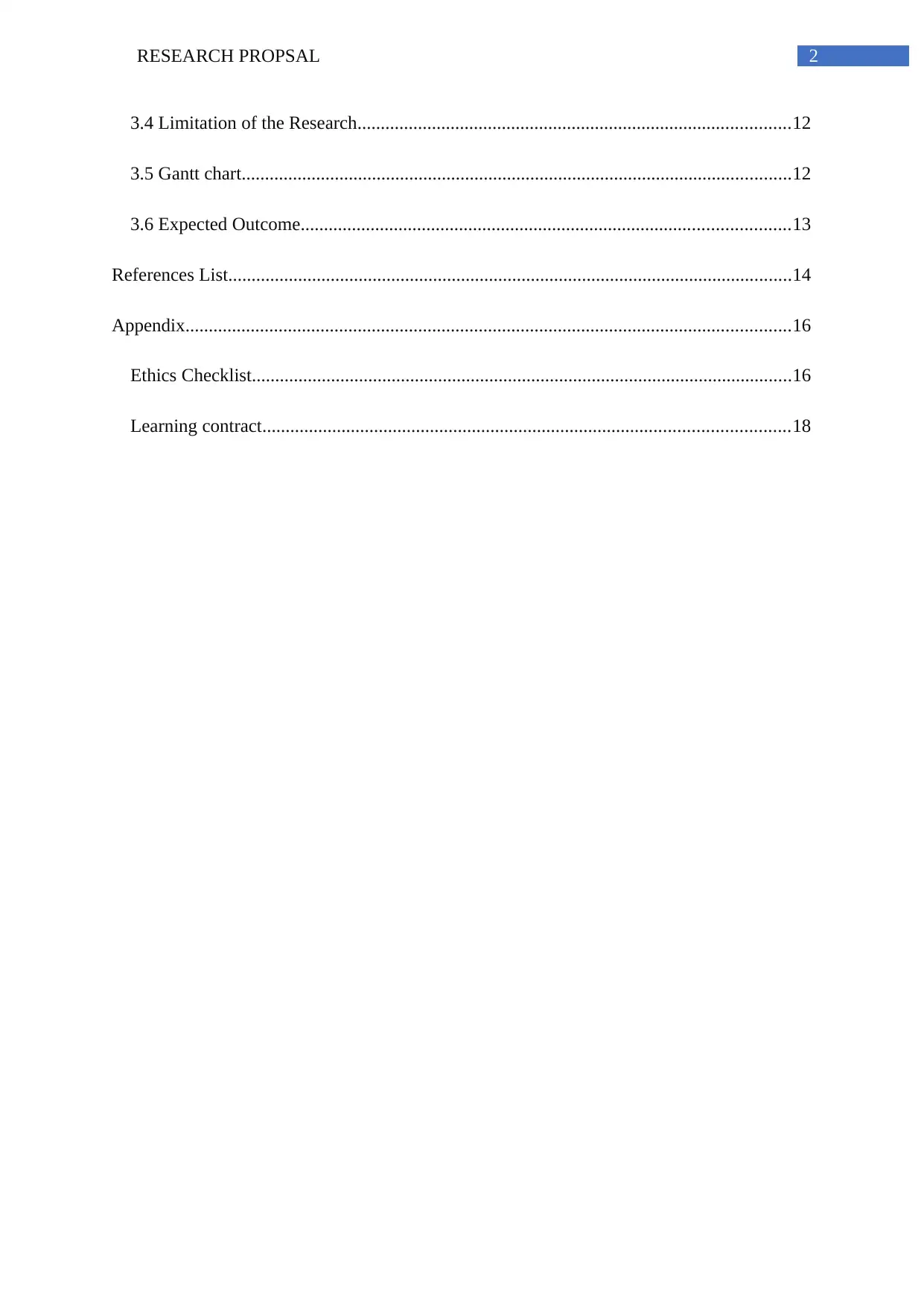
2RESEARCH PROPSAL
3.4 Limitation of the Research.............................................................................................12
3.5 Gantt chart......................................................................................................................12
3.6 Expected Outcome.........................................................................................................13
References List.........................................................................................................................14
Appendix..................................................................................................................................16
Ethics Checklist....................................................................................................................16
Learning contract.................................................................................................................18
3.4 Limitation of the Research.............................................................................................12
3.5 Gantt chart......................................................................................................................12
3.6 Expected Outcome.........................................................................................................13
References List.........................................................................................................................14
Appendix..................................................................................................................................16
Ethics Checklist....................................................................................................................16
Learning contract.................................................................................................................18
⊘ This is a preview!⊘
Do you want full access?
Subscribe today to unlock all pages.

Trusted by 1+ million students worldwide

3RESEARCH PROPSAL
List of Figures:
Figure 1: Gantt chart for the research......................................................................................13
List of Figures:
Figure 1: Gantt chart for the research......................................................................................13
Paraphrase This Document
Need a fresh take? Get an instant paraphrase of this document with our AI Paraphraser

4RESEARCH PROPSAL
CHAPTER 1: INTRODUCTION
1.1Introduction
This chapter will discuss about the background and rational of the study. This will
help to under the research problem. Aim and objectives are provided in this chapter.
1.2 Background of the study
British Petroleum is one of the largest gas and Oil Company in the world.
Headquarter of British Petroleum is situated at London, UK. About 3.8 million barrels of oil
is produced per day ( Selley and Sonnenberg 2014 ). There are approximately 22400 service
stations of Bp in the world (Kiron 2017). It is the third largest company in energy production.
It is the sixth major producer of oil and gas.
Waste management is recurrent challenge for the gas and oil industry (Sharma et al
2013). The recent development in the oil and gas industry has determined a basic change in
the path of the industry. The speedy change has demand a uniformly swift development in the
infrastructure required to gratify the ecological safety demands of gas and oil processes
(Leissle 2018). Some challenges of waste management arise due to the production in the
basins.
1.3 Rational of the study
It is essential to recover the expensive fractions from all kinds of gas and oil. It
reduces the ecological importance of fracturing and drilling. It helps to expose expensive
innovative revenue streams. It surpasses the dictatorial standards for surroundings safety. It is
important to recover the useful materials. The inoperative waste matters are arranged for
waste management (Viney 2014). A diversity of waste-disposal alternatives is used. Some
CHAPTER 1: INTRODUCTION
1.1Introduction
This chapter will discuss about the background and rational of the study. This will
help to under the research problem. Aim and objectives are provided in this chapter.
1.2 Background of the study
British Petroleum is one of the largest gas and Oil Company in the world.
Headquarter of British Petroleum is situated at London, UK. About 3.8 million barrels of oil
is produced per day ( Selley and Sonnenberg 2014 ). There are approximately 22400 service
stations of Bp in the world (Kiron 2017). It is the third largest company in energy production.
It is the sixth major producer of oil and gas.
Waste management is recurrent challenge for the gas and oil industry (Sharma et al
2013). The recent development in the oil and gas industry has determined a basic change in
the path of the industry. The speedy change has demand a uniformly swift development in the
infrastructure required to gratify the ecological safety demands of gas and oil processes
(Leissle 2018). Some challenges of waste management arise due to the production in the
basins.
1.3 Rational of the study
It is essential to recover the expensive fractions from all kinds of gas and oil. It
reduces the ecological importance of fracturing and drilling. It helps to expose expensive
innovative revenue streams. It surpasses the dictatorial standards for surroundings safety. It is
important to recover the useful materials. The inoperative waste matters are arranged for
waste management (Viney 2014). A diversity of waste-disposal alternatives is used. Some
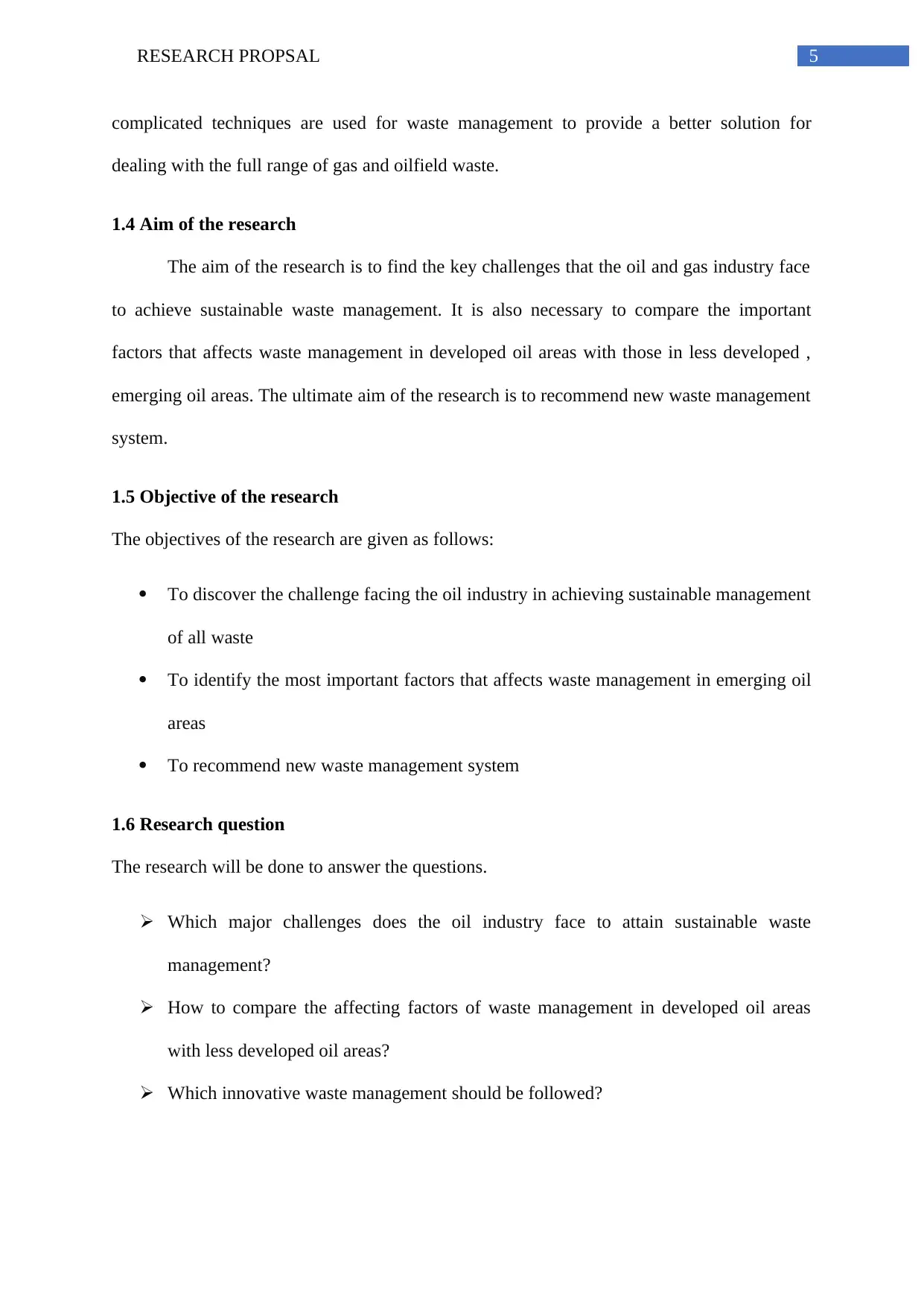
5RESEARCH PROPSAL
complicated techniques are used for waste management to provide a better solution for
dealing with the full range of gas and oilfield waste.
1.4 Aim of the research
The aim of the research is to find the key challenges that the oil and gas industry face
to achieve sustainable waste management. It is also necessary to compare the important
factors that affects waste management in developed oil areas with those in less developed ,
emerging oil areas. The ultimate aim of the research is to recommend new waste management
system.
1.5 Objective of the research
The objectives of the research are given as follows:
To discover the challenge facing the oil industry in achieving sustainable management
of all waste
To identify the most important factors that affects waste management in emerging oil
areas
To recommend new waste management system
1.6 Research question
The research will be done to answer the questions.
Which major challenges does the oil industry face to attain sustainable waste
management?
How to compare the affecting factors of waste management in developed oil areas
with less developed oil areas?
Which innovative waste management should be followed?
complicated techniques are used for waste management to provide a better solution for
dealing with the full range of gas and oilfield waste.
1.4 Aim of the research
The aim of the research is to find the key challenges that the oil and gas industry face
to achieve sustainable waste management. It is also necessary to compare the important
factors that affects waste management in developed oil areas with those in less developed ,
emerging oil areas. The ultimate aim of the research is to recommend new waste management
system.
1.5 Objective of the research
The objectives of the research are given as follows:
To discover the challenge facing the oil industry in achieving sustainable management
of all waste
To identify the most important factors that affects waste management in emerging oil
areas
To recommend new waste management system
1.6 Research question
The research will be done to answer the questions.
Which major challenges does the oil industry face to attain sustainable waste
management?
How to compare the affecting factors of waste management in developed oil areas
with less developed oil areas?
Which innovative waste management should be followed?
⊘ This is a preview!⊘
Do you want full access?
Subscribe today to unlock all pages.

Trusted by 1+ million students worldwide
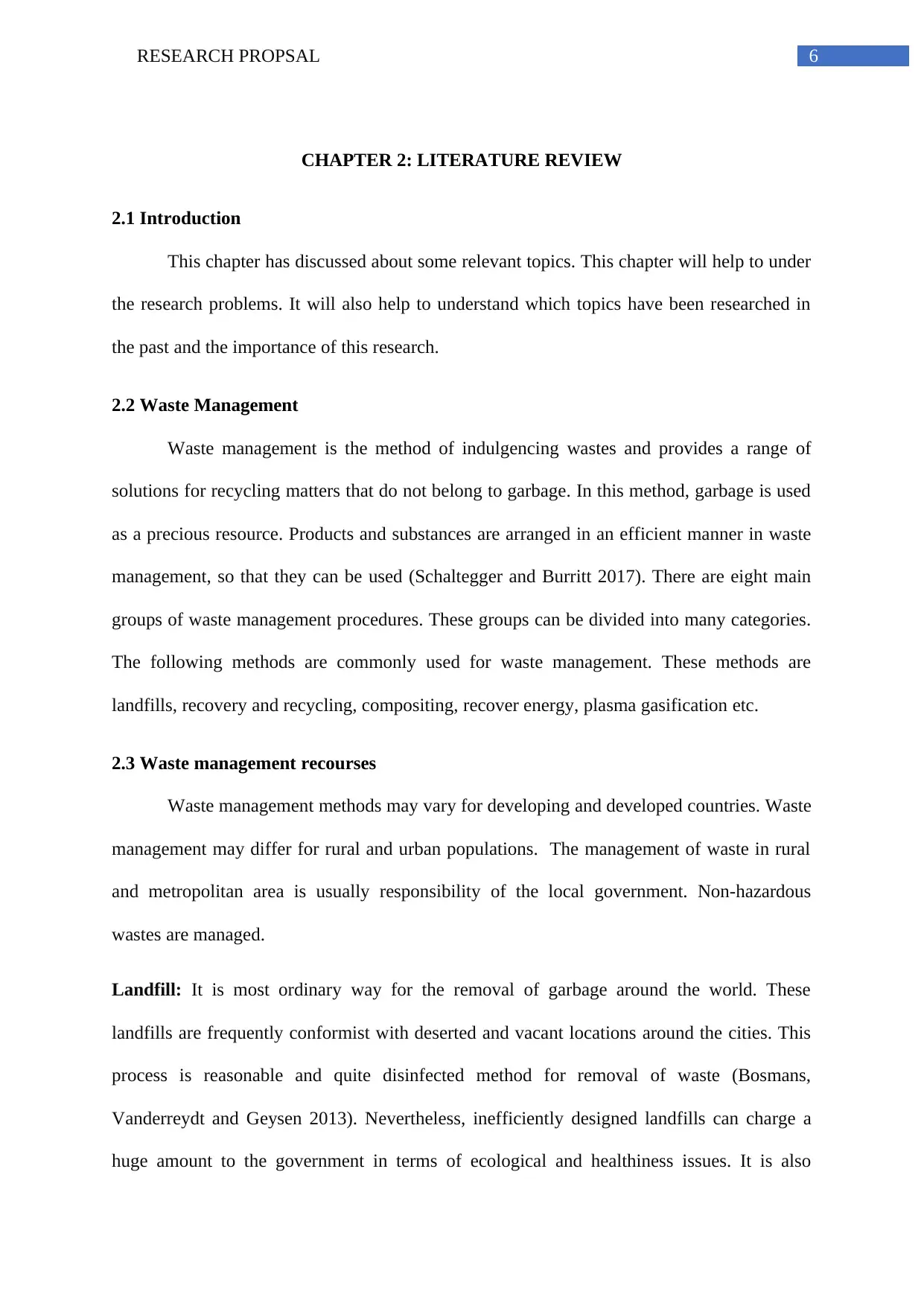
6RESEARCH PROPSAL
CHAPTER 2: LITERATURE REVIEW
2.1 Introduction
This chapter has discussed about some relevant topics. This chapter will help to under
the research problems. It will also help to understand which topics have been researched in
the past and the importance of this research.
2.2 Waste Management
Waste management is the method of indulgencing wastes and provides a range of
solutions for recycling matters that do not belong to garbage. In this method, garbage is used
as a precious resource. Products and substances are arranged in an efficient manner in waste
management, so that they can be used (Schaltegger and Burritt 2017). There are eight main
groups of waste management procedures. These groups can be divided into many categories.
The following methods are commonly used for waste management. These methods are
landfills, recovery and recycling, compositing, recover energy, plasma gasification etc.
2.3 Waste management recourses
Waste management methods may vary for developing and developed countries. Waste
management may differ for rural and urban populations. The management of waste in rural
and metropolitan area is usually responsibility of the local government. Non-hazardous
wastes are managed.
Landfill: It is most ordinary way for the removal of garbage around the world. These
landfills are frequently conformist with deserted and vacant locations around the cities. This
process is reasonable and quite disinfected method for removal of waste (Bosmans,
Vanderreydt and Geysen 2013). Nevertheless, inefficiently designed landfills can charge a
huge amount to the government in terms of ecological and healthiness issues. It is also
CHAPTER 2: LITERATURE REVIEW
2.1 Introduction
This chapter has discussed about some relevant topics. This chapter will help to under
the research problems. It will also help to understand which topics have been researched in
the past and the importance of this research.
2.2 Waste Management
Waste management is the method of indulgencing wastes and provides a range of
solutions for recycling matters that do not belong to garbage. In this method, garbage is used
as a precious resource. Products and substances are arranged in an efficient manner in waste
management, so that they can be used (Schaltegger and Burritt 2017). There are eight main
groups of waste management procedures. These groups can be divided into many categories.
The following methods are commonly used for waste management. These methods are
landfills, recovery and recycling, compositing, recover energy, plasma gasification etc.
2.3 Waste management recourses
Waste management methods may vary for developing and developed countries. Waste
management may differ for rural and urban populations. The management of waste in rural
and metropolitan area is usually responsibility of the local government. Non-hazardous
wastes are managed.
Landfill: It is most ordinary way for the removal of garbage around the world. These
landfills are frequently conformist with deserted and vacant locations around the cities. This
process is reasonable and quite disinfected method for removal of waste (Bosmans,
Vanderreydt and Geysen 2013). Nevertheless, inefficiently designed landfills can charge a
huge amount to the government in terms of ecological and healthiness issues. It is also
Paraphrase This Document
Need a fresh take? Get an instant paraphrase of this document with our AI Paraphraser
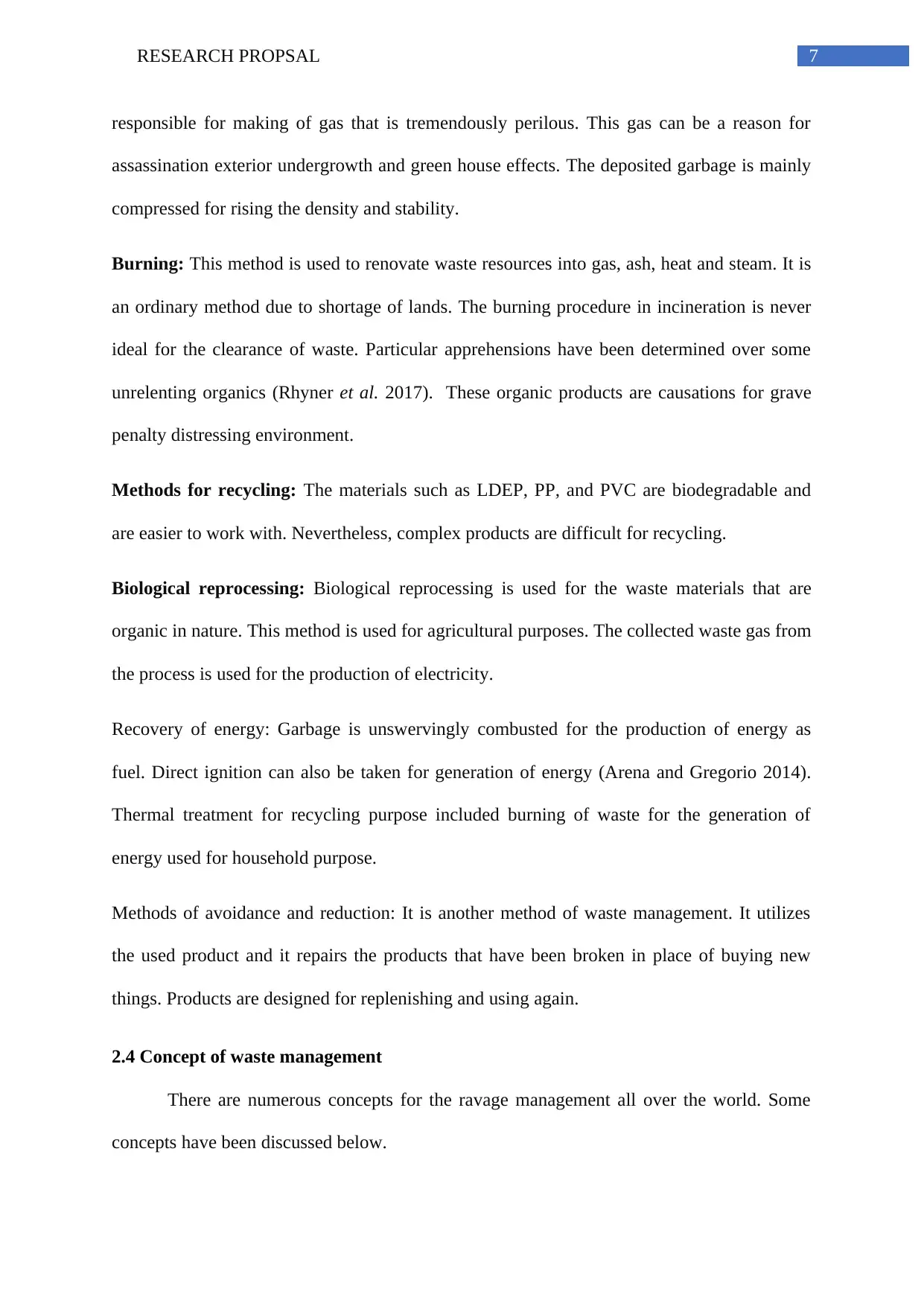
7RESEARCH PROPSAL
responsible for making of gas that is tremendously perilous. This gas can be a reason for
assassination exterior undergrowth and green house effects. The deposited garbage is mainly
compressed for rising the density and stability.
Burning: This method is used to renovate waste resources into gas, ash, heat and steam. It is
an ordinary method due to shortage of lands. The burning procedure in incineration is never
ideal for the clearance of waste. Particular apprehensions have been determined over some
unrelenting organics (Rhyner et al. 2017). These organic products are causations for grave
penalty distressing environment.
Methods for recycling: The materials such as LDEP, PP, and PVC are biodegradable and
are easier to work with. Nevertheless, complex products are difficult for recycling.
Biological reprocessing: Biological reprocessing is used for the waste materials that are
organic in nature. This method is used for agricultural purposes. The collected waste gas from
the process is used for the production of electricity.
Recovery of energy: Garbage is unswervingly combusted for the production of energy as
fuel. Direct ignition can also be taken for generation of energy (Arena and Gregorio 2014).
Thermal treatment for recycling purpose included burning of waste for the generation of
energy used for household purpose.
Methods of avoidance and reduction: It is another method of waste management. It utilizes
the used product and it repairs the products that have been broken in place of buying new
things. Products are designed for replenishing and using again.
2.4 Concept of waste management
There are numerous concepts for the ravage management all over the world. Some
concepts have been discussed below.
responsible for making of gas that is tremendously perilous. This gas can be a reason for
assassination exterior undergrowth and green house effects. The deposited garbage is mainly
compressed for rising the density and stability.
Burning: This method is used to renovate waste resources into gas, ash, heat and steam. It is
an ordinary method due to shortage of lands. The burning procedure in incineration is never
ideal for the clearance of waste. Particular apprehensions have been determined over some
unrelenting organics (Rhyner et al. 2017). These organic products are causations for grave
penalty distressing environment.
Methods for recycling: The materials such as LDEP, PP, and PVC are biodegradable and
are easier to work with. Nevertheless, complex products are difficult for recycling.
Biological reprocessing: Biological reprocessing is used for the waste materials that are
organic in nature. This method is used for agricultural purposes. The collected waste gas from
the process is used for the production of electricity.
Recovery of energy: Garbage is unswervingly combusted for the production of energy as
fuel. Direct ignition can also be taken for generation of energy (Arena and Gregorio 2014).
Thermal treatment for recycling purpose included burning of waste for the generation of
energy used for household purpose.
Methods of avoidance and reduction: It is another method of waste management. It utilizes
the used product and it repairs the products that have been broken in place of buying new
things. Products are designed for replenishing and using again.
2.4 Concept of waste management
There are numerous concepts for the ravage management all over the world. Some
concepts have been discussed below.
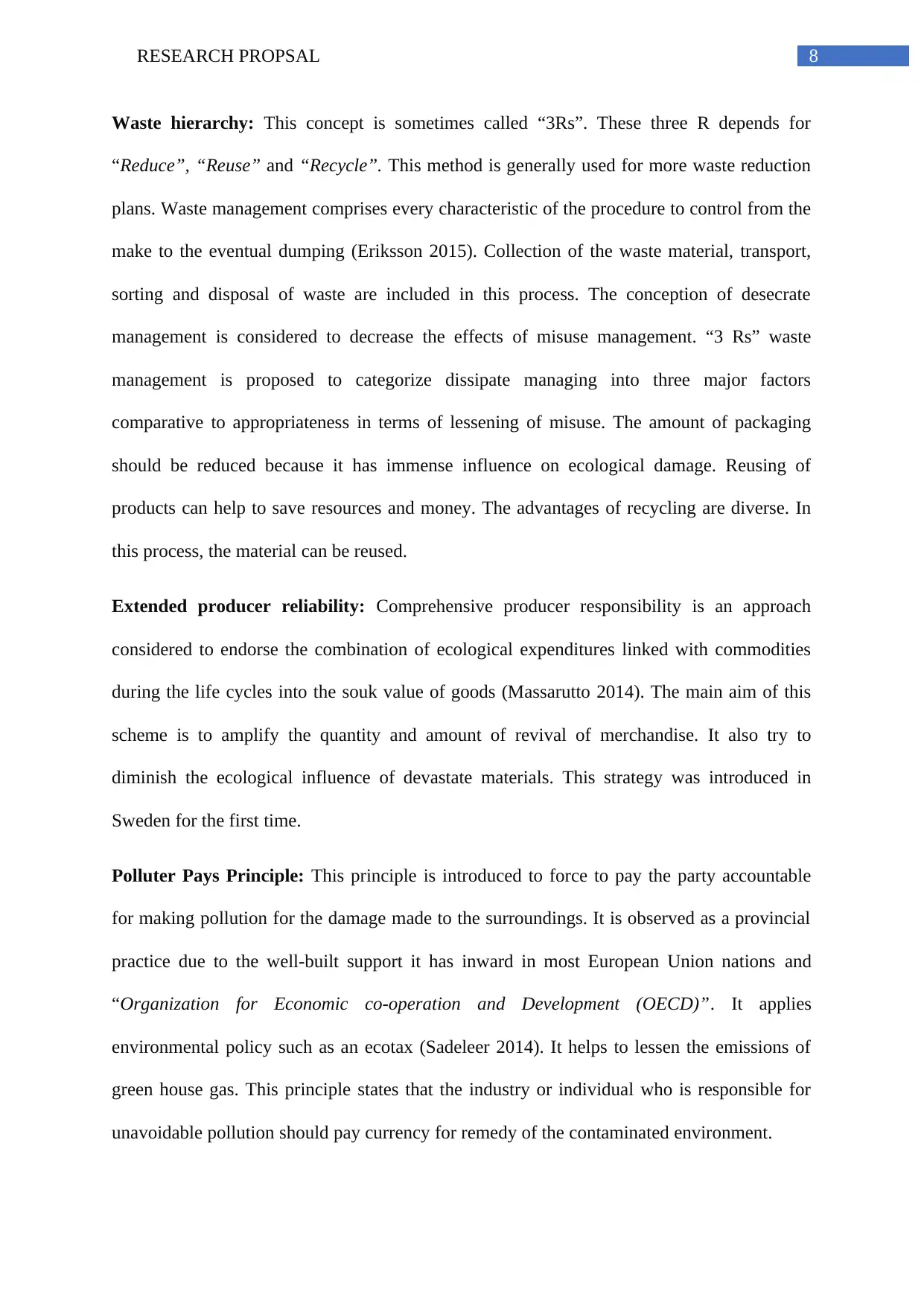
8RESEARCH PROPSAL
Waste hierarchy: This concept is sometimes called “3Rs”. These three R depends for
“Reduce”, “Reuse” and “Recycle”. This method is generally used for more waste reduction
plans. Waste management comprises every characteristic of the procedure to control from the
make to the eventual dumping (Eriksson 2015). Collection of the waste material, transport,
sorting and disposal of waste are included in this process. The conception of desecrate
management is considered to decrease the effects of misuse management. “3 Rs” waste
management is proposed to categorize dissipate managing into three major factors
comparative to appropriateness in terms of lessening of misuse. The amount of packaging
should be reduced because it has immense influence on ecological damage. Reusing of
products can help to save resources and money. The advantages of recycling are diverse. In
this process, the material can be reused.
Extended producer reliability: Comprehensive producer responsibility is an approach
considered to endorse the combination of ecological expenditures linked with commodities
during the life cycles into the souk value of goods (Massarutto 2014). The main aim of this
scheme is to amplify the quantity and amount of revival of merchandise. It also try to
diminish the ecological influence of devastate materials. This strategy was introduced in
Sweden for the first time.
Polluter Pays Principle: This principle is introduced to force to pay the party accountable
for making pollution for the damage made to the surroundings. It is observed as a provincial
practice due to the well-built support it has inward in most European Union nations and
“Organization for Economic co-operation and Development (OECD)”. It applies
environmental policy such as an ecotax (Sadeleer 2014). It helps to lessen the emissions of
green house gas. This principle states that the industry or individual who is responsible for
unavoidable pollution should pay currency for remedy of the contaminated environment.
Waste hierarchy: This concept is sometimes called “3Rs”. These three R depends for
“Reduce”, “Reuse” and “Recycle”. This method is generally used for more waste reduction
plans. Waste management comprises every characteristic of the procedure to control from the
make to the eventual dumping (Eriksson 2015). Collection of the waste material, transport,
sorting and disposal of waste are included in this process. The conception of desecrate
management is considered to decrease the effects of misuse management. “3 Rs” waste
management is proposed to categorize dissipate managing into three major factors
comparative to appropriateness in terms of lessening of misuse. The amount of packaging
should be reduced because it has immense influence on ecological damage. Reusing of
products can help to save resources and money. The advantages of recycling are diverse. In
this process, the material can be reused.
Extended producer reliability: Comprehensive producer responsibility is an approach
considered to endorse the combination of ecological expenditures linked with commodities
during the life cycles into the souk value of goods (Massarutto 2014). The main aim of this
scheme is to amplify the quantity and amount of revival of merchandise. It also try to
diminish the ecological influence of devastate materials. This strategy was introduced in
Sweden for the first time.
Polluter Pays Principle: This principle is introduced to force to pay the party accountable
for making pollution for the damage made to the surroundings. It is observed as a provincial
practice due to the well-built support it has inward in most European Union nations and
“Organization for Economic co-operation and Development (OECD)”. It applies
environmental policy such as an ecotax (Sadeleer 2014). It helps to lessen the emissions of
green house gas. This principle states that the industry or individual who is responsible for
unavoidable pollution should pay currency for remedy of the contaminated environment.
⊘ This is a preview!⊘
Do you want full access?
Subscribe today to unlock all pages.

Trusted by 1+ million students worldwide
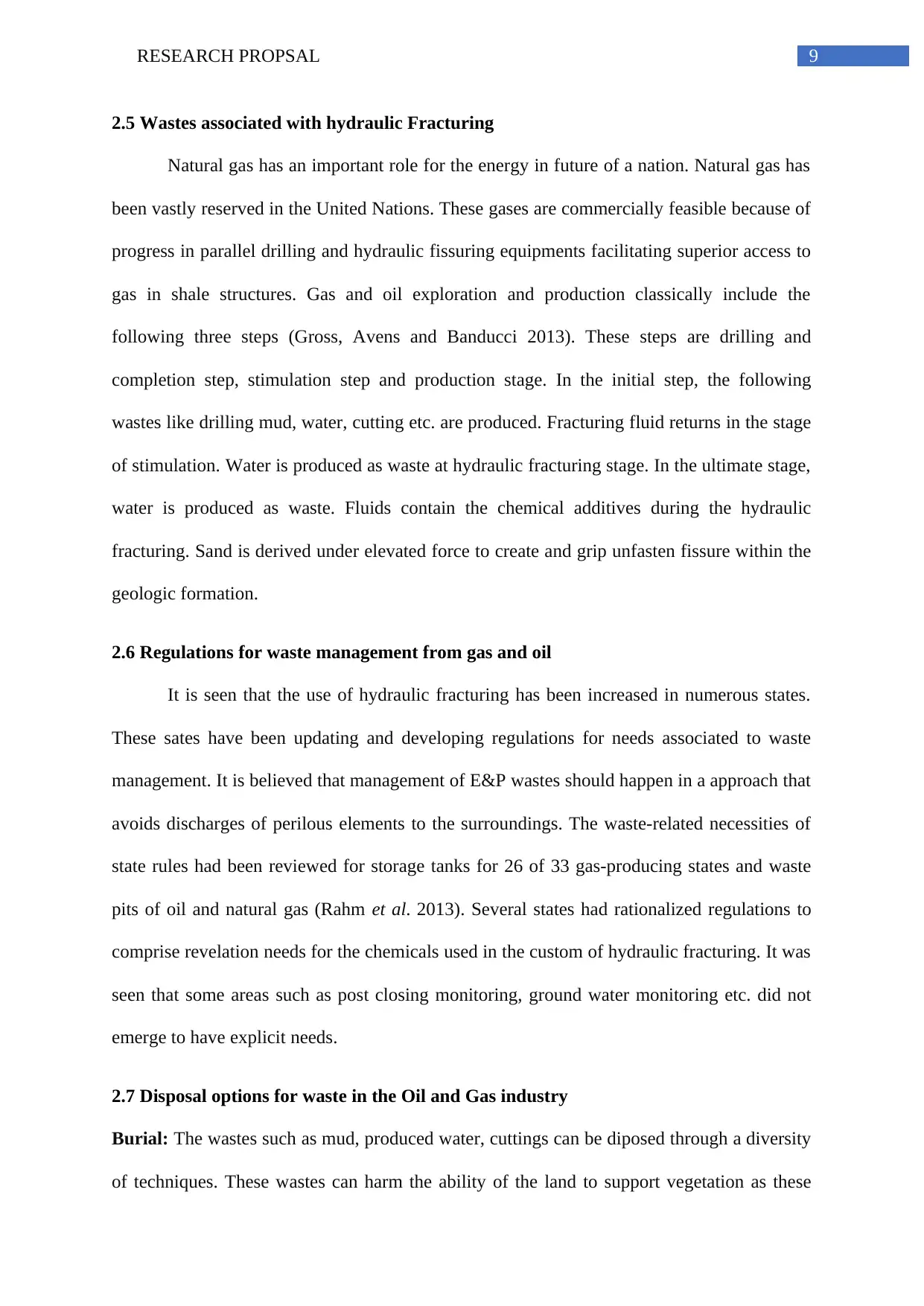
9RESEARCH PROPSAL
2.5 Wastes associated with hydraulic Fracturing
Natural gas has an important role for the energy in future of a nation. Natural gas has
been vastly reserved in the United Nations. These gases are commercially feasible because of
progress in parallel drilling and hydraulic fissuring equipments facilitating superior access to
gas in shale structures. Gas and oil exploration and production classically include the
following three steps (Gross, Avens and Banducci 2013). These steps are drilling and
completion step, stimulation step and production stage. In the initial step, the following
wastes like drilling mud, water, cutting etc. are produced. Fracturing fluid returns in the stage
of stimulation. Water is produced as waste at hydraulic fracturing stage. In the ultimate stage,
water is produced as waste. Fluids contain the chemical additives during the hydraulic
fracturing. Sand is derived under elevated force to create and grip unfasten fissure within the
geologic formation.
2.6 Regulations for waste management from gas and oil
It is seen that the use of hydraulic fracturing has been increased in numerous states.
These sates have been updating and developing regulations for needs associated to waste
management. It is believed that management of E&P wastes should happen in a approach that
avoids discharges of perilous elements to the surroundings. The waste-related necessities of
state rules had been reviewed for storage tanks for 26 of 33 gas-producing states and waste
pits of oil and natural gas (Rahm et al. 2013). Several states had rationalized regulations to
comprise revelation needs for the chemicals used in the custom of hydraulic fracturing. It was
seen that some areas such as post closing monitoring, ground water monitoring etc. did not
emerge to have explicit needs.
2.7 Disposal options for waste in the Oil and Gas industry
Burial: The wastes such as mud, produced water, cuttings can be diposed through a diversity
of techniques. These wastes can harm the ability of the land to support vegetation as these
2.5 Wastes associated with hydraulic Fracturing
Natural gas has an important role for the energy in future of a nation. Natural gas has
been vastly reserved in the United Nations. These gases are commercially feasible because of
progress in parallel drilling and hydraulic fissuring equipments facilitating superior access to
gas in shale structures. Gas and oil exploration and production classically include the
following three steps (Gross, Avens and Banducci 2013). These steps are drilling and
completion step, stimulation step and production stage. In the initial step, the following
wastes like drilling mud, water, cutting etc. are produced. Fracturing fluid returns in the stage
of stimulation. Water is produced as waste at hydraulic fracturing stage. In the ultimate stage,
water is produced as waste. Fluids contain the chemical additives during the hydraulic
fracturing. Sand is derived under elevated force to create and grip unfasten fissure within the
geologic formation.
2.6 Regulations for waste management from gas and oil
It is seen that the use of hydraulic fracturing has been increased in numerous states.
These sates have been updating and developing regulations for needs associated to waste
management. It is believed that management of E&P wastes should happen in a approach that
avoids discharges of perilous elements to the surroundings. The waste-related necessities of
state rules had been reviewed for storage tanks for 26 of 33 gas-producing states and waste
pits of oil and natural gas (Rahm et al. 2013). Several states had rationalized regulations to
comprise revelation needs for the chemicals used in the custom of hydraulic fracturing. It was
seen that some areas such as post closing monitoring, ground water monitoring etc. did not
emerge to have explicit needs.
2.7 Disposal options for waste in the Oil and Gas industry
Burial: The wastes such as mud, produced water, cuttings can be diposed through a diversity
of techniques. These wastes can harm the ability of the land to support vegetation as these
Paraphrase This Document
Need a fresh take? Get an instant paraphrase of this document with our AI Paraphraser
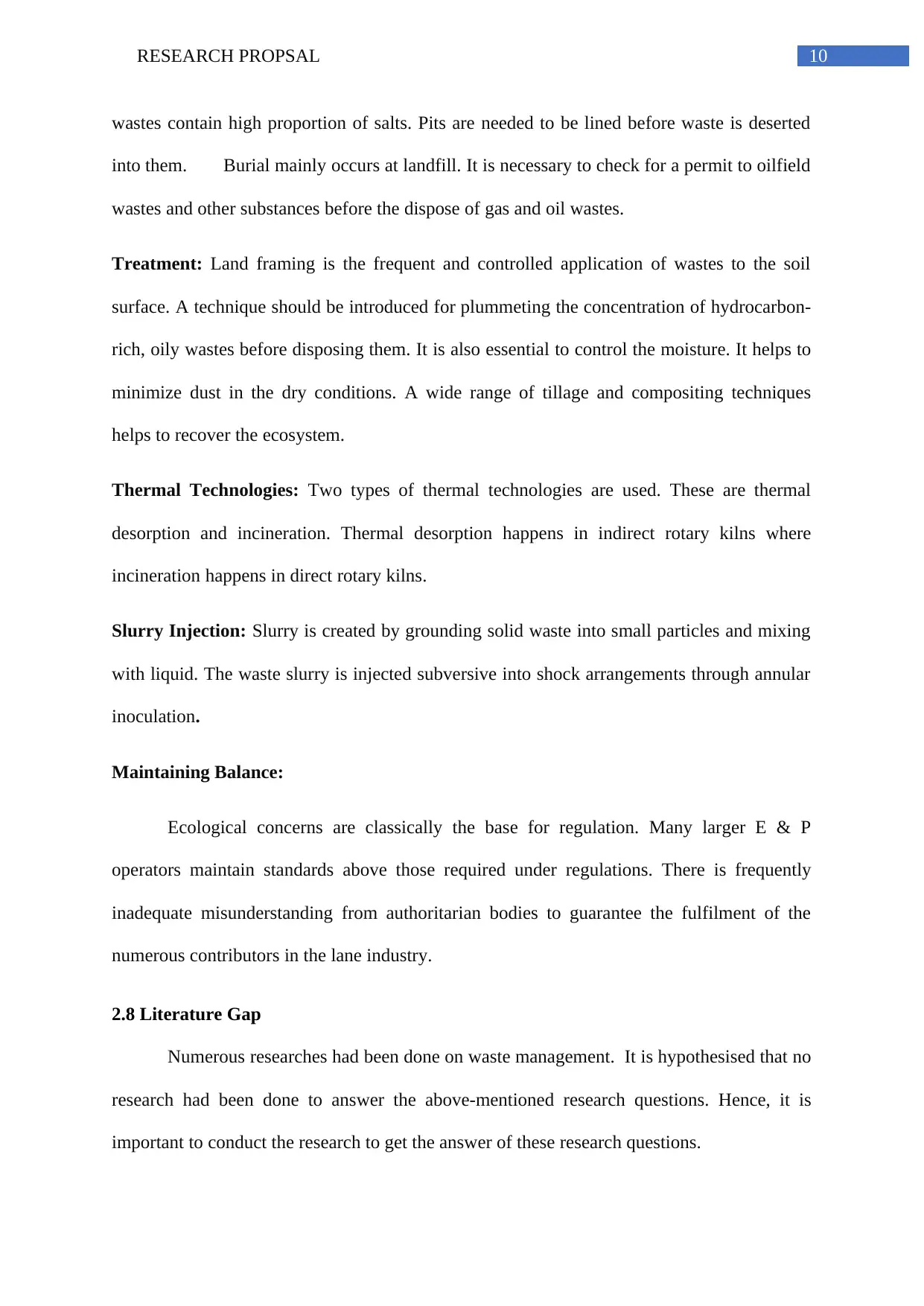
10RESEARCH PROPSAL
wastes contain high proportion of salts. Pits are needed to be lined before waste is deserted
into them. Burial mainly occurs at landfill. It is necessary to check for a permit to oilfield
wastes and other substances before the dispose of gas and oil wastes.
Treatment: Land framing is the frequent and controlled application of wastes to the soil
surface. A technique should be introduced for plummeting the concentration of hydrocarbon-
rich, oily wastes before disposing them. It is also essential to control the moisture. It helps to
minimize dust in the dry conditions. A wide range of tillage and compositing techniques
helps to recover the ecosystem.
Thermal Technologies: Two types of thermal technologies are used. These are thermal
desorption and incineration. Thermal desorption happens in indirect rotary kilns where
incineration happens in direct rotary kilns.
Slurry Injection: Slurry is created by grounding solid waste into small particles and mixing
with liquid. The waste slurry is injected subversive into shock arrangements through annular
inoculation.
Maintaining Balance:
Ecological concerns are classically the base for regulation. Many larger E & P
operators maintain standards above those required under regulations. There is frequently
inadequate misunderstanding from authoritarian bodies to guarantee the fulfilment of the
numerous contributors in the lane industry.
2.8 Literature Gap
Numerous researches had been done on waste management. It is hypothesised that no
research had been done to answer the above-mentioned research questions. Hence, it is
important to conduct the research to get the answer of these research questions.
wastes contain high proportion of salts. Pits are needed to be lined before waste is deserted
into them. Burial mainly occurs at landfill. It is necessary to check for a permit to oilfield
wastes and other substances before the dispose of gas and oil wastes.
Treatment: Land framing is the frequent and controlled application of wastes to the soil
surface. A technique should be introduced for plummeting the concentration of hydrocarbon-
rich, oily wastes before disposing them. It is also essential to control the moisture. It helps to
minimize dust in the dry conditions. A wide range of tillage and compositing techniques
helps to recover the ecosystem.
Thermal Technologies: Two types of thermal technologies are used. These are thermal
desorption and incineration. Thermal desorption happens in indirect rotary kilns where
incineration happens in direct rotary kilns.
Slurry Injection: Slurry is created by grounding solid waste into small particles and mixing
with liquid. The waste slurry is injected subversive into shock arrangements through annular
inoculation.
Maintaining Balance:
Ecological concerns are classically the base for regulation. Many larger E & P
operators maintain standards above those required under regulations. There is frequently
inadequate misunderstanding from authoritarian bodies to guarantee the fulfilment of the
numerous contributors in the lane industry.
2.8 Literature Gap
Numerous researches had been done on waste management. It is hypothesised that no
research had been done to answer the above-mentioned research questions. Hence, it is
important to conduct the research to get the answer of these research questions.
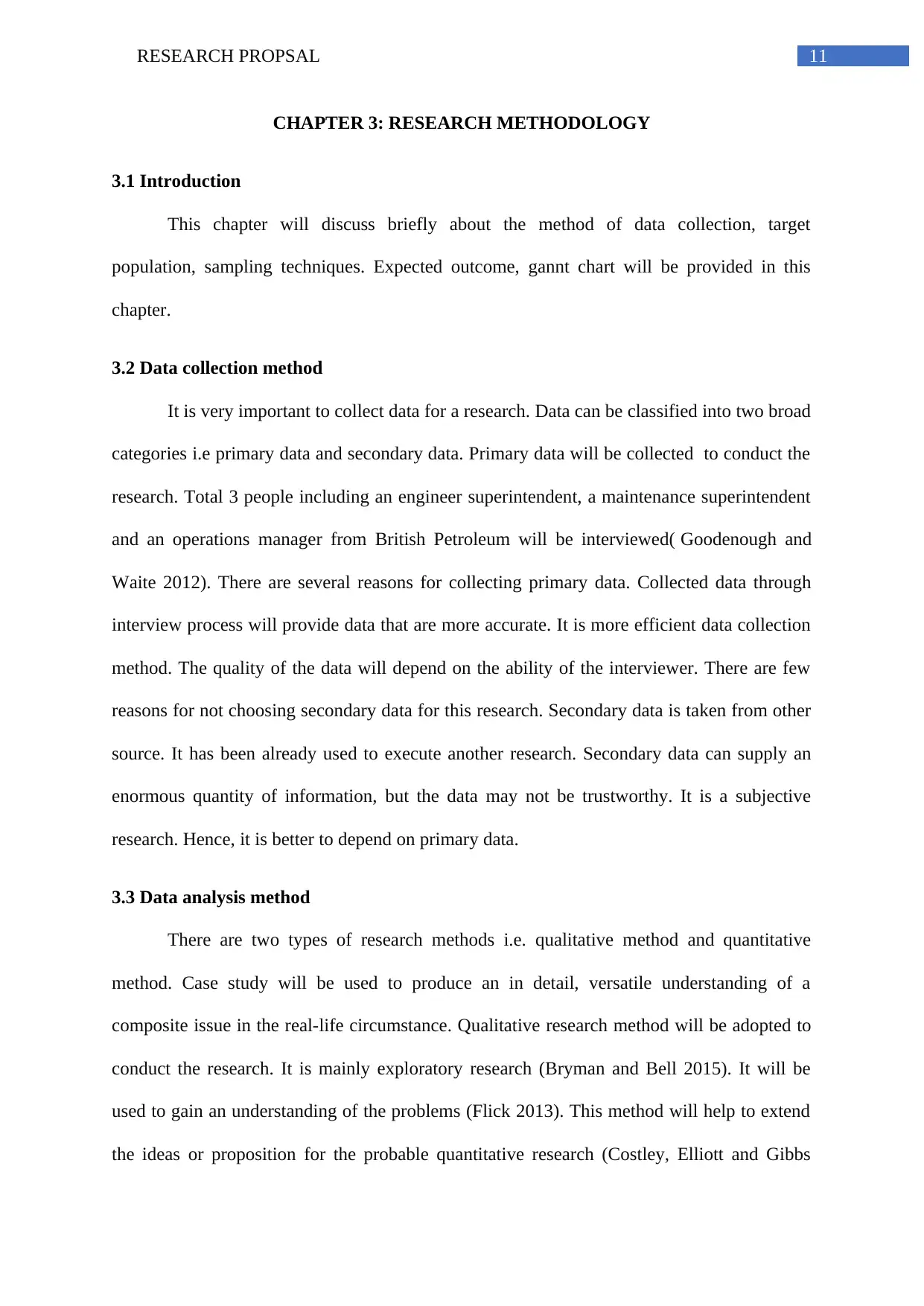
11RESEARCH PROPSAL
CHAPTER 3: RESEARCH METHODOLOGY
3.1 Introduction
This chapter will discuss briefly about the method of data collection, target
population, sampling techniques. Expected outcome, gannt chart will be provided in this
chapter.
3.2 Data collection method
It is very important to collect data for a research. Data can be classified into two broad
categories i.e primary data and secondary data. Primary data will be collected to conduct the
research. Total 3 people including an engineer superintendent, a maintenance superintendent
and an operations manager from British Petroleum will be interviewed( Goodenough and
Waite 2012). There are several reasons for collecting primary data. Collected data through
interview process will provide data that are more accurate. It is more efficient data collection
method. The quality of the data will depend on the ability of the interviewer. There are few
reasons for not choosing secondary data for this research. Secondary data is taken from other
source. It has been already used to execute another research. Secondary data can supply an
enormous quantity of information, but the data may not be trustworthy. It is a subjective
research. Hence, it is better to depend on primary data.
3.3 Data analysis method
There are two types of research methods i.e. qualitative method and quantitative
method. Case study will be used to produce an in detail, versatile understanding of a
composite issue in the real-life circumstance. Qualitative research method will be adopted to
conduct the research. It is mainly exploratory research (Bryman and Bell 2015). It will be
used to gain an understanding of the problems (Flick 2013). This method will help to extend
the ideas or proposition for the probable quantitative research (Costley, Elliott and Gibbs
CHAPTER 3: RESEARCH METHODOLOGY
3.1 Introduction
This chapter will discuss briefly about the method of data collection, target
population, sampling techniques. Expected outcome, gannt chart will be provided in this
chapter.
3.2 Data collection method
It is very important to collect data for a research. Data can be classified into two broad
categories i.e primary data and secondary data. Primary data will be collected to conduct the
research. Total 3 people including an engineer superintendent, a maintenance superintendent
and an operations manager from British Petroleum will be interviewed( Goodenough and
Waite 2012). There are several reasons for collecting primary data. Collected data through
interview process will provide data that are more accurate. It is more efficient data collection
method. The quality of the data will depend on the ability of the interviewer. There are few
reasons for not choosing secondary data for this research. Secondary data is taken from other
source. It has been already used to execute another research. Secondary data can supply an
enormous quantity of information, but the data may not be trustworthy. It is a subjective
research. Hence, it is better to depend on primary data.
3.3 Data analysis method
There are two types of research methods i.e. qualitative method and quantitative
method. Case study will be used to produce an in detail, versatile understanding of a
composite issue in the real-life circumstance. Qualitative research method will be adopted to
conduct the research. It is mainly exploratory research (Bryman and Bell 2015). It will be
used to gain an understanding of the problems (Flick 2013). This method will help to extend
the ideas or proposition for the probable quantitative research (Costley, Elliott and Gibbs
⊘ This is a preview!⊘
Do you want full access?
Subscribe today to unlock all pages.

Trusted by 1+ million students worldwide
1 out of 19
Related Documents
Your All-in-One AI-Powered Toolkit for Academic Success.
+13062052269
info@desklib.com
Available 24*7 on WhatsApp / Email
![[object Object]](/_next/static/media/star-bottom.7253800d.svg)
Unlock your academic potential
Copyright © 2020–2025 A2Z Services. All Rights Reserved. Developed and managed by ZUCOL.





